A long time ago, back in November of 2011, I posted a very short snippet about a new fountain pen that I acquired. Since these types of pens are not very mainstream (to my knowledge), I turned this into a game by masking the photo and asking my readers if they can identify it. It didn't take long for the pen to be identified. I guess I did a poor job at obfuscating it. Anyway, that pen, and the subject of today's review, is a Chinese Jinhao X750 with a broad nib.
It took me this long to review the pen because I've been using it for several weeks with multiple inks.
This was an unplanned purchase but while I was browsing the web a few months ago I came upon these Chinese pens and noticed that brands like Jinhao and Hero have a huge variety of designs. After much research I settled upon a Jinhao. The X750 model seemed decent enough and it was one of the few that offered a broad nib. I picked a checkerboard pattern design.
These pens can be bought for very little from eBay. I bought mine for about $8, shipped. I didn't have much faith that it would write incredibly well but I thought it was worth a shot for the price. I also decided that I would take it to work and use it on a daily basis, something that I am hesitant to do with my more "expensive" pens, or at least those that cost more than $20.
The X750 comes in a blue cardboard box but you might as well throw it away because it's rather cheap-looking.
Body and materials
The Jinhao X750 is the first pen I laid hands on that's made entirely out of brass. The pen itself has a very solid construction and it feels weighty and ponderous in your hand. There are many imperfections in the checkerboard pattern: some of the squares seem faded, others overlap awkwardly, some of them are smudged and so on. Still, the pattern is ingrained in the metal of the body and cap and I don't envision it coming off any time soon. It is definitely not painted on. It could be anodized but I'm no expert.
The X750 has a torpedo shape and both ends are rounded. At each end there's a black plastic finial with a thin piece of silver trim underneath.
The cap features a thick band of silver trim which is real metal and is embossed with "Jinhao" on one side and "X750" on another, with a tribal-like design in between. A little bit gaudy if you ask me but overall the pen is not too kitschy.
One of the things I don't like about the cap is the clip. While decent enough in form and shape, it is extremely stiff. Slipping it over anything is an exercise in strength. In fact I wouldn't even recommend clipping this pen to something sensitive, like a shirt pocket, because you'll end up ripping it to pieces.
Removing the cap and moving to the inside, the first large piece of plastic is finally revealed. I'm referring to the section, which seems to be made from some type of tough plastic but the thread which connects it to the barrel is, once again, brass.
One of the first things you'll notice once you take the cap off is the nib. This is one humongous nib. It is easily the biggest nib in my collection and the only ones that match it are probably the nibs from a Pelikan M1000 or other such high-end fountain pen. I will talk more about the nib and feed further into the review.
Dimensions and weight
As mentioned, the Jinhao X750 is on the large side, both in dimensions and weight. I decided to compare it to my TWSBI Diamond 530 which used to be my largest pen, and the sizes are very similar. Capped, they are almost identical in length.
Uncapped, the TWSBI is longer but the Jinhao has the larger nib. For the uncapped comparison I aligned the two pens by the end of the section, where the nib starts.
Here are some hard numbers for you.
Length capped: 142mm / 5.6in
Length uncapped and un-posted: 127mm / 5in
Length of cap: 62mm / 2.4in
Length of nib: 23mm / 0.9in
Length with cap posted: 162mm / 6.4in
As for weight, this is the heaviest fountain pen I have used. It but it comes close to being uncomfortably so. The balance is good as long as you don't post the cap but if you do, most of the weight will be shifted to the top which makes it very awkward to hold. As a whole, I much rather prefer the TWSBI's weight.
Speaking of the cap, it is a snap-on type and it closes with a very firm CLICK. I much prefer the Pilot Prera's snapping action which is incredibly smooth and cushioned but the Jinhao's snap is very definite and gives you plenty of confidence that the cap will stay put. Indeed, the cap closes very securely and it doesn't wobble in any direction.
Filling mechanism
The Jinhao X750 has a dual-filling system in the sense that it comes with a piston converter which can be replaced with an international cartridge. The converter is fairly cheap looking and it didn't work great for me so I switched to a cartridge. I tried several inks with the X750 and the cartridge handled well. I am of a mind to give the converter a second chance because the inks I used didn't flow very well, so perhaps an ink which flows more easily will work better in it.
One last thing about the converter. There's a small spring inside the converter, between the piston gasket and the opening. I don't know what role it serves, except perhaps to prevent surface tensioning in the ink. I just wish it wasn't there because it has a nasty habit of trapping drops of ink.
Nib and feed
The Jinhao X750's nib is the biggest I've used. I chose the broad version even though Asian broad nibs aren't very common.
Here's a random comparison between a Pilot Prera nib and the Jinhao X750 nib. You can see just how enormous the latter is, compared to the much more delicate Japanese nib. On the other hand, the feeds are about the same size.
Here's another comparison between my 3 broad nibs: Jinhao X750, TWSBI Diamond 530 and Kaweco Classic Sport. You can notice immediately how big the Jinhao nib is, compared to the other two.
The nib is nice looking, with a floral design and the words "Jinhao" and "18kgp" embossed. The "18kgp" I assume means "18 karat gold plated" which, in my opinion, is ridiculous. This is a regular, rhodium-plated nib, there's no gold in it whatsoever.
The feed is plastic with many fins. It looks well made.
Both nib and feed easily slide in and out of the section, with little effort required. This makes it very easy to clean the pen.
Writing experience
So how does this pen stand up to some real-life use? Not very well I'm afraid. For one thing, flow wasn't great from the start. I flushed it well with ammonia solution and that seemed to make a small improvement. Still, I used about 4-5 different inks in this pen and none of them flowed well. The one which did best was Waterman Havana Brown which is also one of my favorite inks. On the other hand, this particular ink likes to flow really well so it's understandable that it performed well in the Jinhao.
Maybe it's the broad nib or this particular nib or poor quality control in general (though I suspect it's the latter) but I constantly struggled with this pen. It would dry up from one day to the next so I had to "exercise" it every time I picked it up in the morning. It would also dry up slightly between uses which made it skip for the first few words.
After a couple of words it would let up but it still had problems with certain letters, most notably the downstroke on lowercase letter "l" (for Larry).
In its defense, I did use a bunch of waterproof Noodler's inks (to be reviewed soon) which were kind of slow flowing and quick drying but I also tried Noodler's Navajo Turquoise a few days ago and the pen would barely write.
In the Jinhao's defense, it did write better on smooth, good quality paper such as Rhodia or Clairefontaine but that's not a big excuse because I really enjoy a fountain pen which writes well on any type of paper.
The other thing that I didn't really enjoy about the Jinhao X750 is the weight of it. That brass is heavy! Though the pen feels very solid, my fingers and hand start to tire after using it a while. It is simply too heavy for long sessions of comfortable writing.
In the end I just gave up on this pen.
Wrap-up
As you can see, the Jinhao X750 has some great potential but it is let down by poor quality control and the cumbersome weight of its body. I have no doubt that, were you to buy one, you would have different luck than me. I'm also tempted to try a medium or fine nib but I'm not sure I want to sink more money in these pens, no matter how cheap they are. For $8 shipped, the Jinhao X750 was not a bad experiment. It just didn't work out for me. There are plenty of people who've had good experiences with Jinhao fountain pens. If you are one of them, please drop me a line.
Here's a writing sample on Clairefontaine 90g paper, in Waterman Havana Brown ink.


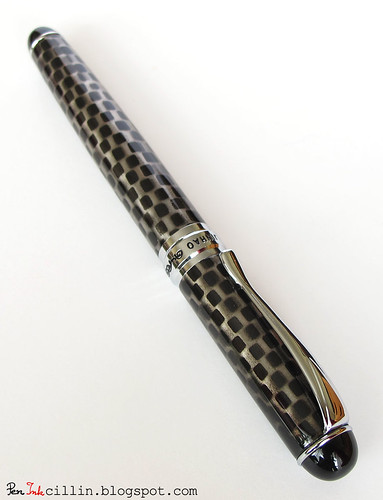

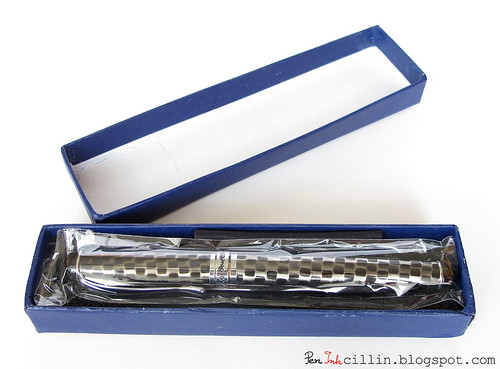
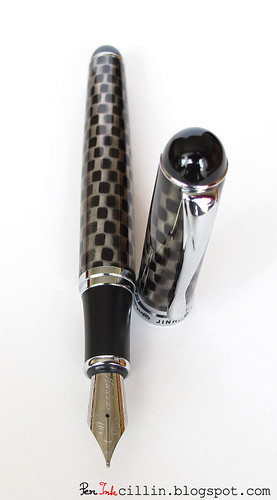





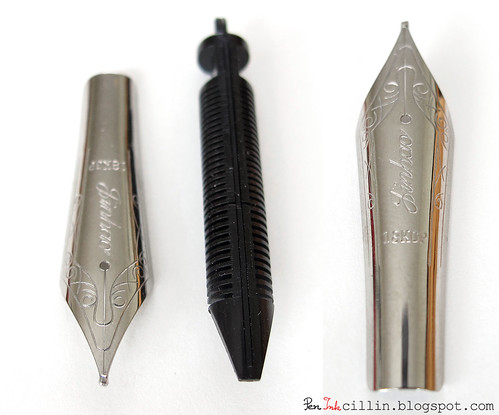

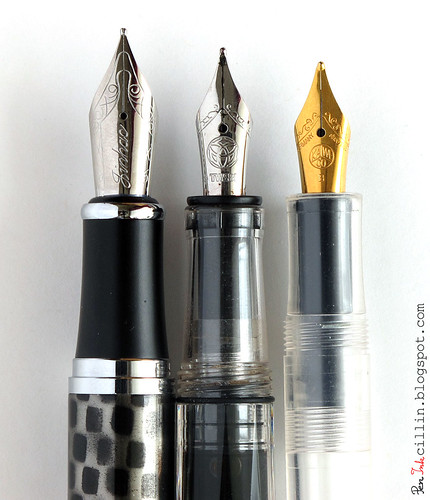

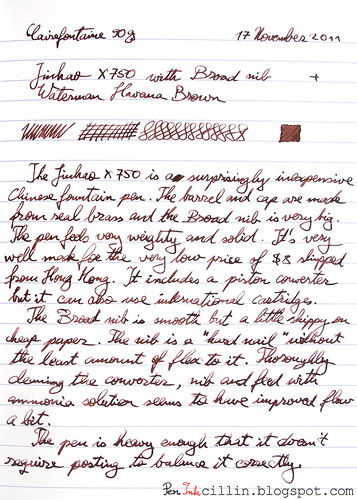
Thanks for the heads-up. I have had some good luck with Chinese fountain pens and also some not so great luck. As you point out, for the price it was worth experimenting with.
ReplyDeleteWhich ones did you try?
ReplyDeleteI have a Hero 100 which is good and a Regal which is good. I haven't tried my Picasso yet. I am not home right now but will have to take a look when I return.
ReplyDeleteI have one of these pens (a milk-colored medium) and have had some flow issues with it, too. While it writes, it writes nicely, but I have had to do some tinkering with the feed in terms of deepening the channels with a razor blade, removing the feeder tube, etc. Usually it'll give out after a certain number of words and I'll have to give it a vigorous shake to get it going again, and then it's fine. So it might be a feed issue in your case, too.
ReplyDeleteThat is possible. My feed doesn't have a feeder tube, it's a newer version, otherwise I would have removed it.
ReplyDeleteYeah, and you've got twin grooves down the top of yours whereas I only have one. Sounds like they tried to address their feed problems and actually made matters worse.
ReplyDeleteThose grooves are very narrow, probably less than a razor blade. I might try to widen them, see if that improves flow.
ReplyDeleteIf you only had the photos, this would still be an excellent post. Very nice details on this one. I had considered purchasing some of these flashy Chinese pens to try, but I keep hearing the same story - typically not worth it.
ReplyDeleteThank you :) It was very long in the making.
ReplyDeleteIf you can get one of these under $10, it might be worth a try. On FPN a lot of people are happy with them. Maybe if you try an M or F you might have better luck.
Great review as usual!
ReplyDeleteI had one of these a long while ago. My experience was very good with it. Worked like a charm right out of the box.
To be honest, pens like these really smack pens like the Ahab Flex around. For the price, you get a lot more (in my opinion). Of course, I like the heavy metal body, so that contributes to my liking this pen. But even so, to me at least, I see more quality in this pen (got mine for about $10.00) than I do in then $20.00 Ahab Flex.
Here's where they really excel though - if you want to learn to grind nibs, these are perfect! They have plenty of tipping for a stub or italic grind, and are cheap enough to buy up for practice.
Anyways, thank you for the thorough and well done review.
If I may ask - what setup do you use for your photos? They look a lot like mine, but yours seem a little bit nicer I think. :)
Thanks Tyler!
ReplyDeleteThese pens aren't bad at all for the money. Like you said, they are good to experiment with. Still, I think that a Varsity or Preppy write much better, even though they are pretty much disposable.
About the photos, the setup is simple actually. I place the sheets on a chair, in front of a window and shoot them from directly above. I only use natural light. Unfortunately I have to process them because I don't feel they look natural otherwise. Getting perfect ink photos is impossible and that's one of the things that I dislike about photographing them.
I've yet to try a Varsity or Preppy - I assume you've had pretty good experiences with both though? I'll have to pick one up eventually. I also want to try one of those Pilot Parallel pens - those look really cool.
ReplyDeleteSounds like you're setup is pretty much the exact same as mine! What kind of camera do you use?
Yea, trying to nail the color on inks is very tough for me. My scanner is pretty bad, and my camera can be just ridiculous sometimes...
The Varsity is amazing for a $3 pen. And it has huge ink capacity. The nib is very smooth. Right now I'm writing with a Preppy with a medium nib, which is more like the B on my TWSBI :) It's also very smooth. I like to test inks in these cheap pens because I can take them to work and I won't mind too much if they get stained by stubborn inks *coughbaystatebluecough*
ReplyDeleteI use a Canon G11. Excellent quality for a P&S, as well as manual controls and the vari-angle screen. This camera works great on a tripod.
Your experience with the Jinhao sound the same as mine. I kept hearing great things about them and they are cheap so I ended up with four of them hoping to finally hit a winner. Nope... Not one of the four will write properly with any ink that I use. I have scrubbed the feed, widened the channels, etc... nothing. But the nib is smooth and I found that if you stick it in a Noodler's Ahab it makes for a very wet, smooth writing nib.
ReplyDeleteWhat nib sizes have you tried? I can't help but wondering if medium and fine nibs aren't better than my broad nib.
ReplyDeleteThe Ahab tip is awesome, I never thought of that. I really need to give it a try.
I hate to come in on this discussion so late, but I have an x750 in white and love it. I've tried a few Chinese pens and have had flow issues with all of them, but not this one. Wrote right out of the box with nary a skip. I'm using Montblanc Lavender and haven't had any issues. I'm guessing that the biggest problem with Chinese pens is quality control. You get a good one, great; you don't, you've thrown your money away. But it isn't much money, after all.
ReplyDeleteYou nailed it! That was my impression too: poor quality control or complete lack of it. Luckily these pens aren't very expensive.
ReplyDeleteUnlike your experience I now own 10 Chinese pens from Jinhao, Duke, Baoer and Hero and not had a bad pen amongst them. Every one of them has been blessed with a smooth nib, although I have always chosen a medium option.
ReplyDeleteThe worst I had was one of the Baoers which required two flush cycles to get it to feed properly but I now like this one so much it is my everyday writer in my diary. None of the nibs have much in the way of flex.
I use these pens with Diamine ink, usually Onyx Black or Ancient Copper.
Chinese quality control seems to have advanced very quickly and the quality of their lacquer for example is up there with some of the big names.
In contrast, I have two Parker Sonnets, each one of them costing as much as my entire Chinese collection, and neither of these has a decent feed with one of them usually refusing to start for several minutes before it will give any ink.
Well, it's the luck of the draw. I'm still not convinced about their quality control, especially after hearing many people on FPN having various issues with Chinese pens. In truth, any mass-produced pen can have issues. As a matter of fact my brand new Lamy AL-Star had some nib issues which I subsequently fixed. I'd be actually willing to try another Chinese pen but I'm not buying any new pens for the time being.
ReplyDeleteHello,
ReplyDeleteI'm using the 750 with a knox extra fine nib and I love it. I feel the flow is better than with the broad nib that the pen came with. I write a lot of math equations and the broad nib wasted too much ink.
Thanks for the great review.
You shouldn't use Noodler's Ink -- it is a pen killer. Read all about it on rihardspens.com (no affiliation).
ReplyDeleteHave you tried opening the nib slit a bit with brass shims? I have a jinhao x750 also with a medium nib and had the same problem for a while but then I bought a set of .001, .002 brass shims from amazon and ran the .002 shim in the slit a few times. After fiddling with it, the pen writes a lot better. I then uses some micro mesh to smooth out the tip of the nib and now it writes as smooth as glass. There is a youtube video on nib tuning
ReplyDeletehttp://youtu.be/r_bNRrPk5MY
and I watched that before getting all the shims and micro mesh to try it myself. Also you can get a nib from goulet pens and their goulet nibs are fantastic. I use the goulet nib if I want a two tone gold/silver look and that nib writes very nice out of the box.
Best of luck, I am a fountain pen freak and have too many pens and the worst thing is that I do most of my writing on a computer.
Thanks for this. To be honest I don't remember if I tried fixing it back at the time. I have fixed a Lamy AL-Star the way you describe (minus the micro mesh) with some of my "tools":
ReplyDeletehttp://peninkcillin.blogspot.com/2012/02/cheap-nib-flossing-tool.html
http://peninkcillin.blogspot.com/2012/04/3-dollar-nib-flossing-tool.html
I just couldn't be bothered to fiddle with such a cheap pen. Maybe one day when I'm bored...
Hey thanks! I find the X750 a bit too heavy. I have 3 other Chinese pens that I haven't got around to reviewing but am rather excited to see how they perform (low expectations though). I snagged them off ebay for very little, something like $2.50 a piece. Hope I can make some time this year to fill them up and take them for a spin.
ReplyDelete